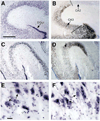Cellular changes in the postmortem hippocampus in major depression
- PMID: 15522247
- PMCID: PMC2929806
- DOI: 10.1016/j.biopsych.2004.08.022
Cellular changes in the postmortem hippocampus in major depression
Abstract
Background: Imaging studies report that hippocampal volume is decreased in major depressive disorder (MDD). A cellular basis for reduced hippocampal volume in MDD has not been identified.
Methods: Sections of right hippocampus were collected in 19 subjects with MDD and 21 normal control subjects. The density of pyramidal neurons, dentate granule cell neurons, glia, and the size of the neuronal somal area were measured in systematic, randomly placed three-dimensional optical disector counting boxes.
Results: In MDD, cryostat-cut hippocampal sections shrink in depth a significant 18% greater amount than in control subjects. The density of granule cells and glia in the dentate gyrus and pyramidal neurons and glia in all cornv ammonis (CA)/hippocampal subfields is significantly increased by 30%-35% in MDD. The average soma size of pyramidal neurons is significantly decreased in MDD.
Conclusion: In MDD, the packing density of glia, pyramidal neurons, and granule cell neurons is significantly increased in all hippocampal subfields and the dentate gyrus, and pyramidal neuron soma size is significantly decreased as well. It is suggested that a significant reduction in neuropil in MDD may account for decreased hippocampal volume detected by neuroimaging. In addition, differential shrinkage of frozen sections of the hippocampus suggests differential water content in hippocampus in MDD.
Figures



References
-
- Amaral DG, Insausti R. Hippocampal formation. In: Paxinos G, editor. The Human Nervous System. San Diego: Academic Press; 1990. pp. 711–755.
-
- Andersen BB, Gundersen HJ. Pronounced loss of cell nuclei and anisotropic deformation of thick sections. J Microsc. 1999;196:69–73. - PubMed
-
- Arnold SE, Franz BR, Gur RC, Gur RE, Shapiro RM, Moberg PJ, Trojanowski JQ. Smaller neuron size in schizophrenia in hippocampal subfields that mediate cortical-hippocampal interactions. Am J Psychiatry. 1995;152:738–748. - PubMed
-
- Benes FM, Kwok EW, Vincent SL, Todtenkopf MS. A reduction of nonpyramidal cells in sector CA2 of schizophrenics and manic depressives. Biol Psychiatry. 1998;44:88–97. - PubMed
-
- Bowley MP, Drevets WC, Ongur D, Price JL. Low glial numbers in the amygdala in major depressive disorder. Biol Psychiatry. 2002;52:404–412. - PubMed
Publication types
MeSH terms
Grants and funding
LinkOut - more resources
Full Text Sources

